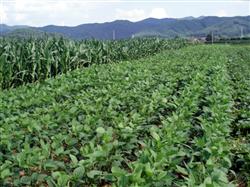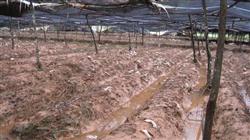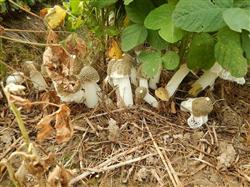How to interplant soybean with Dictyophora?

How to interplant soybean with Dictyophora? Please introduce Dictyophora interplanting soybeans to solve the problem of sunshade, save costs, and increase the income of soybeans in the first season. The following planting methods are for reference: first, the cultivation season: according to the local climatic conditions and the growth characteristics of Dictyophora, the suitable cultivation season is when the temperature is stable for 7 ℃ and 30 min, and the seeds are sown in spring from February to May. Second, prepare and prepare materials before cultivation: after late autumn rice or autumn harvest crops are harvested, choose acidic soil fields with convenient drainage and irrigation, close to water sources, no pollution, loose soil and rich in humus, good aggregate structure and not easy to consolidate. The hilly fields adjacent to the upstream of the cultivation site must be fields that have not been planted with Dictyophora in the past 4 years. Xiangyang is selected in high-altitude mountain areas, and semi-overcast and semi-sunny fields should be selected in low-altitude areas with high summer temperature, and ploughing and tanning ahead of time. 100% husks can be used for cultivation. The husk can be stored all the year round. Seven days before sowing, weeds and debris were removed on a sunny day, soil masses were broken, fields were raked, lime was sprinkled, and phoxim 700 times solution was used for disinfection. Third, the selection of strain and the water content of culture material: the bacteria with white hyphae, thick and sturdy and fasciculate were selected, and the age of bacteria was 60 ~ 70 days. The culture material (grain husk) is soaked and soaked before sowing, and the water content can reach 60 per cent. Fourth, stacking and sowing: the soaked husks will be stacked into a border surface with a width of 70 cm and a height of 20 cm according to the north-south direction, leaving 30 cm between the material beds as drainage ditches. When the chaff is 15 centimeters thick Sow the lump bacteria hole in the center of the culture material (half of the 700 bottles per mu), then add a 5 cm grain hull, gently pat the remaining half of the bacteria with a wooden board or pole, and then sprinkle the remaining half of the bacteria on the material surface. Then, in the ditch that has been reserved for 30 cm on the edge of the cultivation material border, the soil is covered with 8 cm soil, and the water content of the covered soil is better to be held by hand and dispersed. Finally, it is covered with straw to moisturize. Fifth, soybean interplanting techniques: select improved varieties of late-maturing soybean. Because the growth period of late-maturing soybean is long, the shading time is long, and the branches and leaves are luxuriant, the shading degree is large. Before and after the sting, direct seeding and border surface on both sides, the plant distance of 50 cm, staggered with each other, do not sow symmetrically. 6. Cultivation management: 1. The soil should always be kept moist after sowing. It is generally required that the cultivation materials and soil moisture should be kept at 60 per cent, properly watered and moisturized in the dry season (more than seven days after sunny days), and water-soaked horses for 3 hours in long-term drought. Drainage in time in the rainy season, so that the rain stops the water to dry, in case the cultivation material is too hydrated and anaerobic fermentation blackens. two。 Soybean management: generally apply 1Mel compound fertilizer for three times to promote the rapid growth of soybean and shade earlier. If the vegetative growth of soybean is too strong when it is harvested, the basal branches can be cut off properly. 3. Pull out the weeds on the border before the formation of Dictyophora eggs. 4. Pest control: when mites, termites and other pests are found, dichlorvos can be sprayed with 700 times liquid spray. 7. Harvesting and processing: Dictyophora eggs should be picked in time when the umbrella is opened, and should be harvested at about 6 o'clock in the morning, and the fungal cord should be cut off from the bottom of the fungal receptacle with a knife. When the fruiting body is harvested, do not destroy the bacterial bed by pulling hard with your hands, thus affecting the output of the next period. in order to improve the product quality, the fruiting body can be harvested before the skirt of the bamboo sun fruiting body, and the collected bamboo shoot will be cut off the top 2 cm with a knife immediately, and then gently cut longitudinally to the bacterial cover to peel off the green tissue. Discard the fungus receptacle, put the fungus skirt normally and put it on a bamboo screen with sand cloth for drying, then tie it into small bundles according to grade, put it into a plastic bag and put it into a carton and store it in a cool place for sale. Click to get more planting techniques of Dictyophora, click to get more planting techniques of edible fungi
- Prev

How to manage bamboo shoot after flood?
How to manage bamboo shoot after flood? Please introduce that Dictyophora should be managed as follows: 1. Dictyophora, which has been soaked in the flood, drain the water and wash away the dirt on the border in time; 2. Wash off the shade and cover it in time to prevent the sun from being exposed to the sun after the rain; 3. When the weather clears up after the rain, the bamboo shoot border surface is hardened, should be in.
- Next

How does Dictyophora grow raw materials without shed?
How does Dictyophora grow raw materials without shed? Please introduce Dictyophora, known as the "fungal queen", is a valuable edible fungus in China. Since the successful cultivation of Dictyophora in the field in Gutian County, Fujian Province in the early 1990s, it has been inoculated in the spring of that year, and the fungus culture has entered the harvest period, with a yield per square meter.
Related
- Fuxing push coffee new agricultural production and marketing class: lack of small-scale processing plants
- Jujube rice field leisure farm deep ploughing Yilan for five years to create a space for organic food and play
- Nongyu Farm-A trial of organic papaya for brave women with advanced technology
- Four points for attention in the prevention and control of diseases and insect pests of edible fungi
- How to add nutrient solution to Edible Fungi
- Is there any good way to control edible fungus mites?
- Open Inoculation Technology of Edible Fungi
- Is there any clever way to use fertilizer for edible fungus in winter?
- What agents are used to kill the pathogens of edible fungi in the mushroom shed?
- Rapid drying of Edible Fungi

